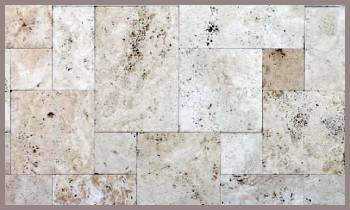Once upon a time, in the mystical world of natural stones, two popular characters emerged: Shell Stone and Travertine. They both possessed unique qualities that made them the perfect fit for various applications.
This engaging story will take you through the pros and cons of these two stones, helping you understand which one is better suited for your needs.
A Brief Comparison Table
| Feature | Shell Stone | Travertine |
| Composition | Sedimentary rock, primarily shells and skeletal fragments | Limestone, formed by minerals deposited by hot springs |
| Colors | White, gray, beige, with hints of pink and yellow | Beige, brown, gold, rust |
| Durability | Dense and hard, suitable for high-traffic areas | Softer than Shell Stone, susceptible to scratches and dents |
| Slip Resistance | Naturally slip-resistant | Less slip-resistant than Shell Stone |
| Aesthetics | Unique, fossil-rich appearance | Earthy tones and natural veining |
| Temperature Regulation | Stays cool in hot weather | Stays cool in hot weather |
| Maintenance | Requires sealing, susceptible to staining | Requires sealing, susceptible to staining |
| Environmental Friendliness | Natural stone, requires less energy to produce | Natural stone, requires less energy to produce |
| Versatility | Primarily used for outdoor applications | Suitable for both indoor and outdoor applications |
| Price | Can be more expensive than other natural stones like Travertine | Generally more affordable than Shell Stone |
The Origin of Shell Stone and Travertine
Shell Stone: Born from the Sea
Shell Stone, a true gift from the ocean, is a sedimentary rock formed primarily from the shells and skeletal fragments of marine organisms. It is a treasure trove of ancient history, providing glimpses of the sea creatures that once inhabited the waters.
Shell Stone can be found in various shades of white, gray, and beige, with subtle hints of pink and yellow.
Travertine: The Gift of Hot Springs
On the other side of the world of natural stones, Travertine was born in the depths of hot springs. A type of limestone, it is formed when minerals, particularly calcium carbonate, are deposited by hot springs or geothermal vents.
Travertine comes in a range of hues, from soft beiges and browns to vibrant golds and rusts.
The Battle of the Pros
Shell Stone’s Strengths

- Durability
One of the reasons Shell Stone is so popular is its durability. Its dense composition and hardness make it an excellent choice for high-traffic areas like driveways, walkways, and patios.
- Slip Resistance
Shell Stone’s natural texture offers slip resistance, making it an ideal choice for pool decks and other wet areas.
- Aesthetics
With its unique composition and fossil-rich appearance, Shell Stone adds an elegant, one-of-a-kind touch to any design project.
- Environmentally Friendly
As a natural stone, Shell Stone requires less energy to produce compared to man-made materials, making it a more sustainable option.
Travertine’s Strengths

- Versatility
Travertine is a versatile stone, suitable for both indoor and outdoor applications. It can be used as flooring, countertops, backsplashes, and more.
- Elegant Appeal
Travertine’s earthy tones and natural veining add a touch of elegance to any design, making it a popular choice for upscale projects.
- Temperature Regulation
Travertine has a natural ability to stay cool, even in hot weather, making it a popular choice for pool decks and outdoor spaces in warmer climates.
- Ease of Maintenance
Travertine’s porous nature allows it to be easily cleaned and maintained, ensuring its beauty lasts for years.
The Clash of the Cons
Shell Stone’s Weaknesses
- Limited Color Palette
Shell Stone’s color range is limited, primarily to neutral tones. This can be a drawback for those seeking a more vibrant or varied color scheme.
- Porosity
Shell Stone is porous, making it more susceptible to staining and damage from acidic substances. Proper sealing and maintenance are necessary to preserve its beauty.
- Expense
Due to its unique composition and limited availability, Shell Stone can be more expensive than other natural stones like travertine.
Travertine’s Weaknesses
- Softness
Travertine’s softness makes it susceptible to scratches and dents, which can be a concern in high-traffic areas.
- Porosity
Like Shell Stone, Travertine is porous and requires regular sealing and maintenance to protect it from staining and damage.
- Inconsistency
Travertine’s natural veining and color variations can make it difficult to achieve a consistent look across a large area or multiple design elements. This can be a challenge for those seeking a uniform appearance.
Frequently Asked Questions
There is no one-size-fits-all answer to this question, as the best stone for your pool area depends on factors like climate, design preferences, and budget. That being said, both Shell Stone and Travertine are popular choices for pool decks due to their slip resistance and ability to stay cool in hot weather.
Yes, Shell Stone is a popular choice for pool decks because of its slip-resistant texture and ability to stay cool even in hot climates. Its durability and unique aesthetic also make it an attractive option for outdoor spaces.
Shell Stone is a sedimentary rock primarily composed of shells and skeletal fragments of marine organisms. These fossil-rich fragments are bound together by minerals, such as calcium carbonate, creating a dense and durable stone.
Shellstone pavers are pieces of Shell Stone that have been cut and shaped for use in outdoor applications, such as patios, driveways, walkways, and pool decks. They offer the same benefits as Shell Stone, including durability, slip resistance, and a unique, fossil-rich appearance.
Yes, Shell Stone is a natural stone formed over millions of years from the shells and skeletal fragments of marine organisms. Its unique composition gives it a one-of-a-kind aesthetic that sets it apart from other natural stones.
Shell Stone is porous, which means it can be susceptible to staining, especially from acidic substances like wine, citrus fruits, and certain cleaning products. To minimize the risk of staining, it is essential to seal your Shell Stone surfaces regularly and to clean spills promptly.
The Verdict: Which Stone Reigns Supreme?
While both Shell Stone and Travertine have their strengths and weaknesses, the ultimate decision comes down to personal preference and the specific requirements of your project. If you are looking for a durable, slip-resistant, and environmentally friendly option with a unique, fossil-rich appearance, Shell Stone may be your ideal choice.
On the other hand, if you desire a versatile and elegant stone that stays cool in hot weather and is easy to maintain, Travertine may be the perfect fit for your needs.



